Nursing Assignment: Jonathan Case Study, Healthcare Intervention Plan
VerifiedAdded on 2023/01/23
|7
|1625
|99
Case Study
AI Summary
This nursing assignment presents a case study of Jonathan, a 16-year-old who experienced health complications after playing bubble soccer in high temperature and humidity. The assignment utilizes the Levett-Jones clinical reasoning cycle to analyze Jonathan's presenting symptoms, including elevated blood pressure, increased pulse and respiratory rates, and flushed skin. The analysis explores potential causes such as dehydration, obesity, and disruption of homeostasis. The assignment highlights the importance of assessing past medical history and understanding the physiological impact of physical activity in adverse environmental conditions. It also identifies potential healthcare interventions, such as hydration and monitoring vital signs, to address Jonathan's condition and prevent further complications. The assignment emphasizes the role of nurses in providing effective care based on clinical reasoning and evidence-based practice. It also discusses the application of anatomy and principles of physiology to understand the patient's critical healthcare situation.
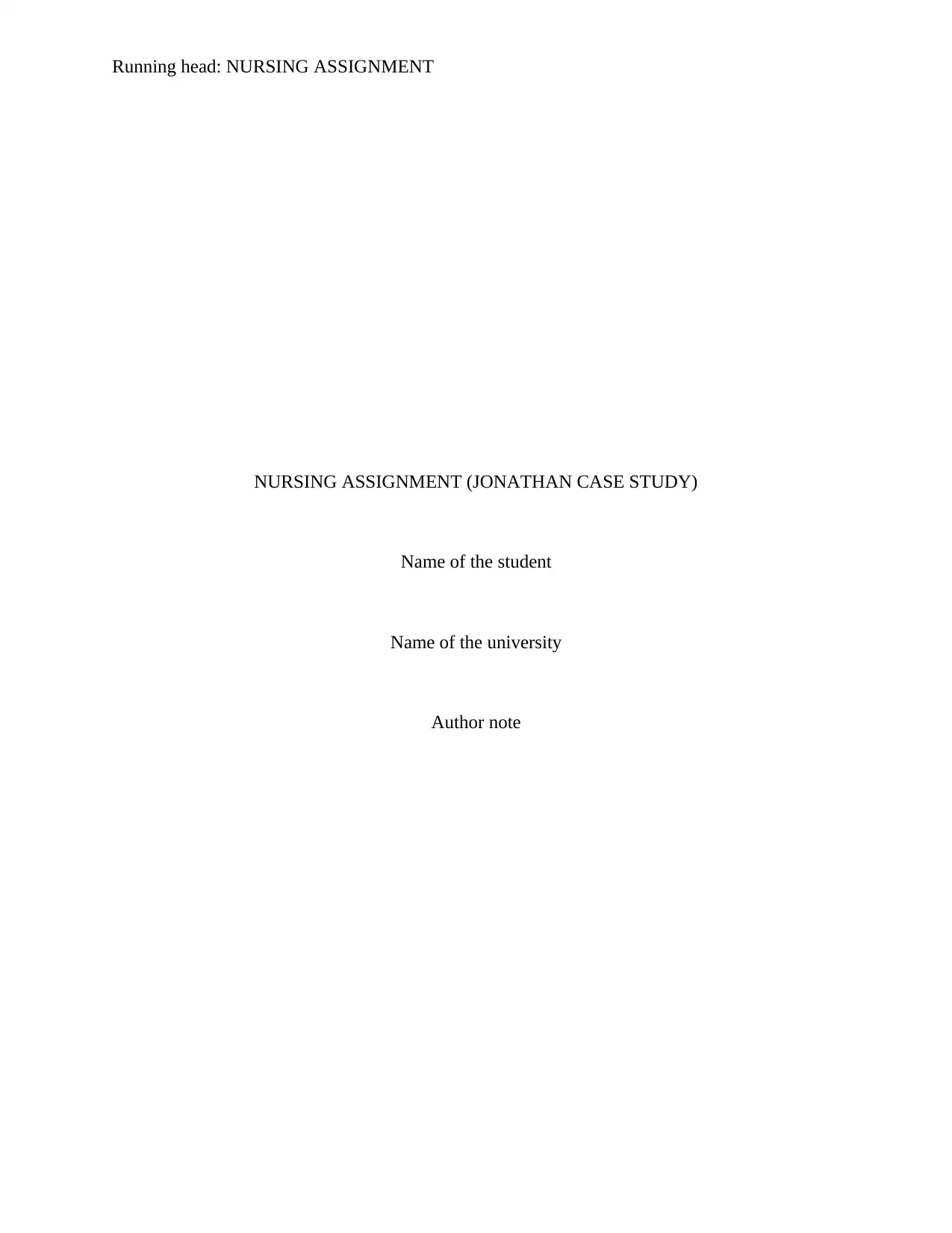
Running head: NURSING ASSIGNMENT
NURSING ASSIGNMENT (JONATHAN CASE STUDY)
Name of the student
Name of the university
Author note
NURSING ASSIGNMENT (JONATHAN CASE STUDY)
Name of the student
Name of the university
Author note
Paraphrase This Document
Need a fresh take? Get an instant paraphrase of this document with our AI Paraphraser
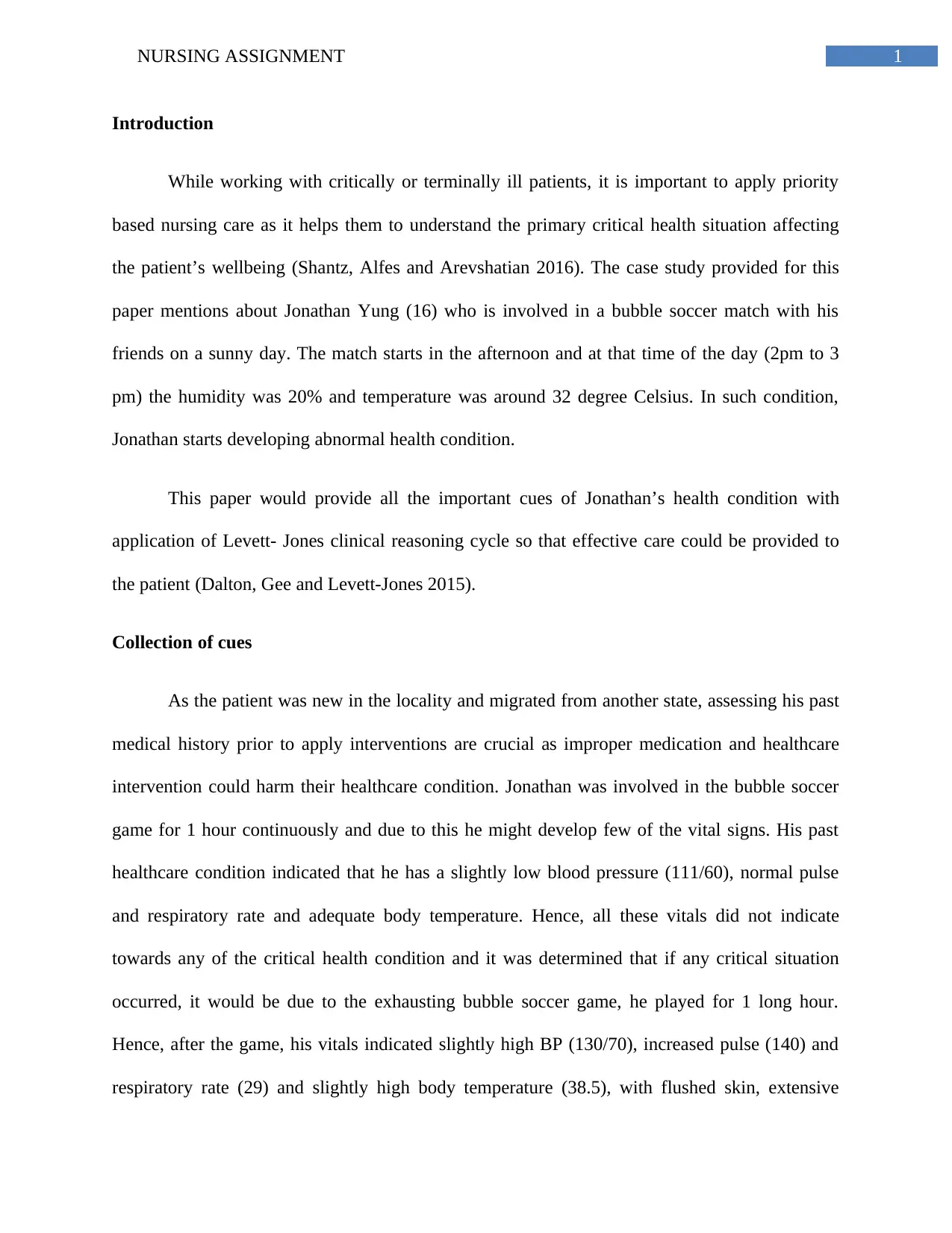
1NURSING ASSIGNMENT
Introduction
While working with critically or terminally ill patients, it is important to apply priority
based nursing care as it helps them to understand the primary critical health situation affecting
the patient’s wellbeing (Shantz, Alfes and Arevshatian 2016). The case study provided for this
paper mentions about Jonathan Yung (16) who is involved in a bubble soccer match with his
friends on a sunny day. The match starts in the afternoon and at that time of the day (2pm to 3
pm) the humidity was 20% and temperature was around 32 degree Celsius. In such condition,
Jonathan starts developing abnormal health condition.
This paper would provide all the important cues of Jonathan’s health condition with
application of Levett- Jones clinical reasoning cycle so that effective care could be provided to
the patient (Dalton, Gee and Levett-Jones 2015).
Collection of cues
As the patient was new in the locality and migrated from another state, assessing his past
medical history prior to apply interventions are crucial as improper medication and healthcare
intervention could harm their healthcare condition. Jonathan was involved in the bubble soccer
game for 1 hour continuously and due to this he might develop few of the vital signs. His past
healthcare condition indicated that he has a slightly low blood pressure (111/60), normal pulse
and respiratory rate and adequate body temperature. Hence, all these vitals did not indicate
towards any of the critical health condition and it was determined that if any critical situation
occurred, it would be due to the exhausting bubble soccer game, he played for 1 long hour.
Hence, after the game, his vitals indicated slightly high BP (130/70), increased pulse (140) and
respiratory rate (29) and slightly high body temperature (38.5), with flushed skin, extensive
Introduction
While working with critically or terminally ill patients, it is important to apply priority
based nursing care as it helps them to understand the primary critical health situation affecting
the patient’s wellbeing (Shantz, Alfes and Arevshatian 2016). The case study provided for this
paper mentions about Jonathan Yung (16) who is involved in a bubble soccer match with his
friends on a sunny day. The match starts in the afternoon and at that time of the day (2pm to 3
pm) the humidity was 20% and temperature was around 32 degree Celsius. In such condition,
Jonathan starts developing abnormal health condition.
This paper would provide all the important cues of Jonathan’s health condition with
application of Levett- Jones clinical reasoning cycle so that effective care could be provided to
the patient (Dalton, Gee and Levett-Jones 2015).
Collection of cues
As the patient was new in the locality and migrated from another state, assessing his past
medical history prior to apply interventions are crucial as improper medication and healthcare
intervention could harm their healthcare condition. Jonathan was involved in the bubble soccer
game for 1 hour continuously and due to this he might develop few of the vital signs. His past
healthcare condition indicated that he has a slightly low blood pressure (111/60), normal pulse
and respiratory rate and adequate body temperature. Hence, all these vitals did not indicate
towards any of the critical health condition and it was determined that if any critical situation
occurred, it would be due to the exhausting bubble soccer game, he played for 1 long hour.
Hence, after the game, his vitals indicated slightly high BP (130/70), increased pulse (140) and
respiratory rate (29) and slightly high body temperature (38.5), with flushed skin, extensive
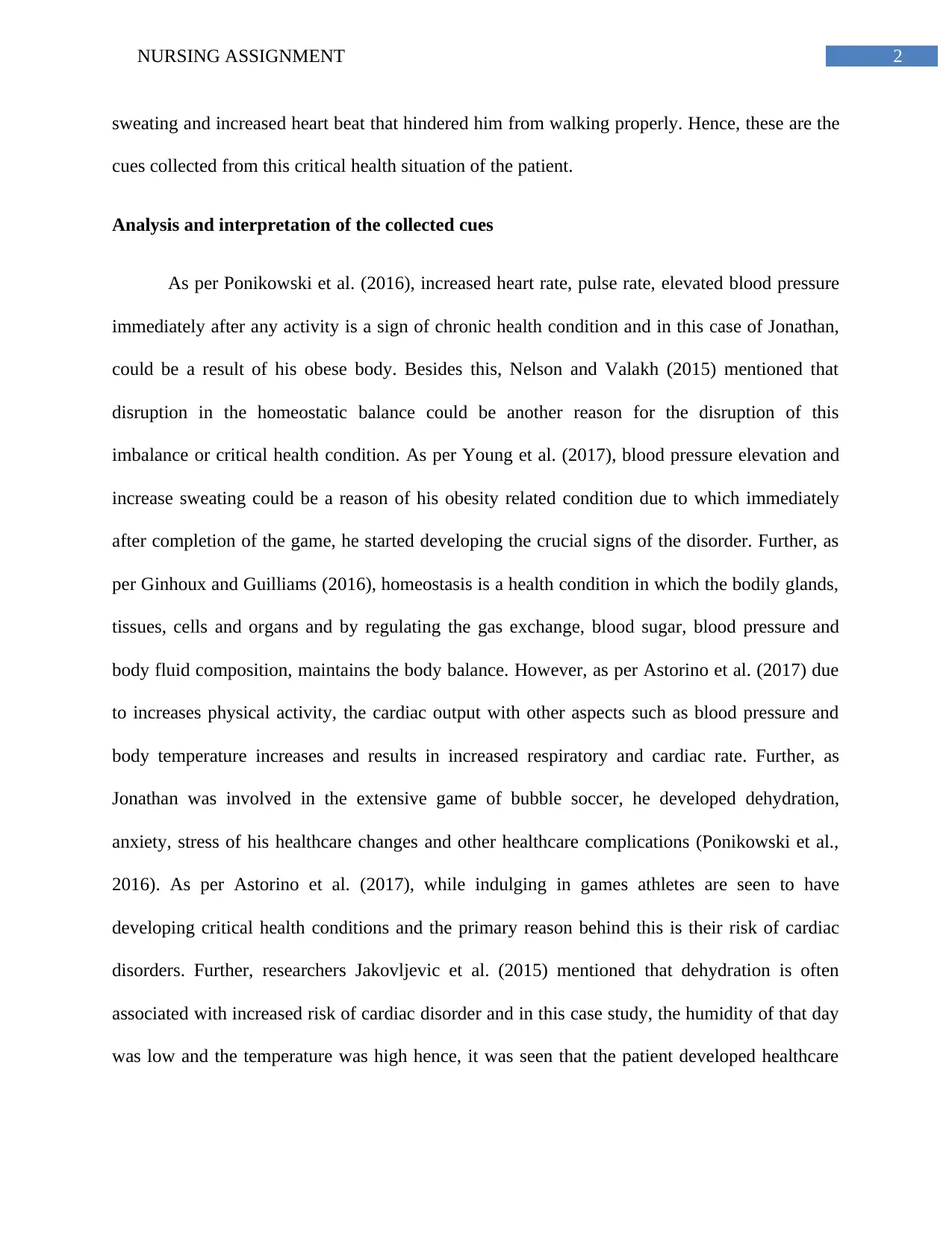
2NURSING ASSIGNMENT
sweating and increased heart beat that hindered him from walking properly. Hence, these are the
cues collected from this critical health situation of the patient.
Analysis and interpretation of the collected cues
As per Ponikowski et al. (2016), increased heart rate, pulse rate, elevated blood pressure
immediately after any activity is a sign of chronic health condition and in this case of Jonathan,
could be a result of his obese body. Besides this, Nelson and Valakh (2015) mentioned that
disruption in the homeostatic balance could be another reason for the disruption of this
imbalance or critical health condition. As per Young et al. (2017), blood pressure elevation and
increase sweating could be a reason of his obesity related condition due to which immediately
after completion of the game, he started developing the crucial signs of the disorder. Further, as
per Ginhoux and Guilliams (2016), homeostasis is a health condition in which the bodily glands,
tissues, cells and organs and by regulating the gas exchange, blood sugar, blood pressure and
body fluid composition, maintains the body balance. However, as per Astorino et al. (2017) due
to increases physical activity, the cardiac output with other aspects such as blood pressure and
body temperature increases and results in increased respiratory and cardiac rate. Further, as
Jonathan was involved in the extensive game of bubble soccer, he developed dehydration,
anxiety, stress of his healthcare changes and other healthcare complications (Ponikowski et al.,
2016). As per Astorino et al. (2017), while indulging in games athletes are seen to have
developing critical health conditions and the primary reason behind this is their risk of cardiac
disorders. Further, researchers Jakovljevic et al. (2015) mentioned that dehydration is often
associated with increased risk of cardiac disorder and in this case study, the humidity of that day
was low and the temperature was high hence, it was seen that the patient developed healthcare
sweating and increased heart beat that hindered him from walking properly. Hence, these are the
cues collected from this critical health situation of the patient.
Analysis and interpretation of the collected cues
As per Ponikowski et al. (2016), increased heart rate, pulse rate, elevated blood pressure
immediately after any activity is a sign of chronic health condition and in this case of Jonathan,
could be a result of his obese body. Besides this, Nelson and Valakh (2015) mentioned that
disruption in the homeostatic balance could be another reason for the disruption of this
imbalance or critical health condition. As per Young et al. (2017), blood pressure elevation and
increase sweating could be a reason of his obesity related condition due to which immediately
after completion of the game, he started developing the crucial signs of the disorder. Further, as
per Ginhoux and Guilliams (2016), homeostasis is a health condition in which the bodily glands,
tissues, cells and organs and by regulating the gas exchange, blood sugar, blood pressure and
body fluid composition, maintains the body balance. However, as per Astorino et al. (2017) due
to increases physical activity, the cardiac output with other aspects such as blood pressure and
body temperature increases and results in increased respiratory and cardiac rate. Further, as
Jonathan was involved in the extensive game of bubble soccer, he developed dehydration,
anxiety, stress of his healthcare changes and other healthcare complications (Ponikowski et al.,
2016). As per Astorino et al. (2017), while indulging in games athletes are seen to have
developing critical health conditions and the primary reason behind this is their risk of cardiac
disorders. Further, researchers Jakovljevic et al. (2015) mentioned that dehydration is often
associated with increased risk of cardiac disorder and in this case study, the humidity of that day
was low and the temperature was high hence, it was seen that the patient developed healthcare
⊘ This is a preview!⊘
Do you want full access?
Subscribe today to unlock all pages.

Trusted by 1+ million students worldwide
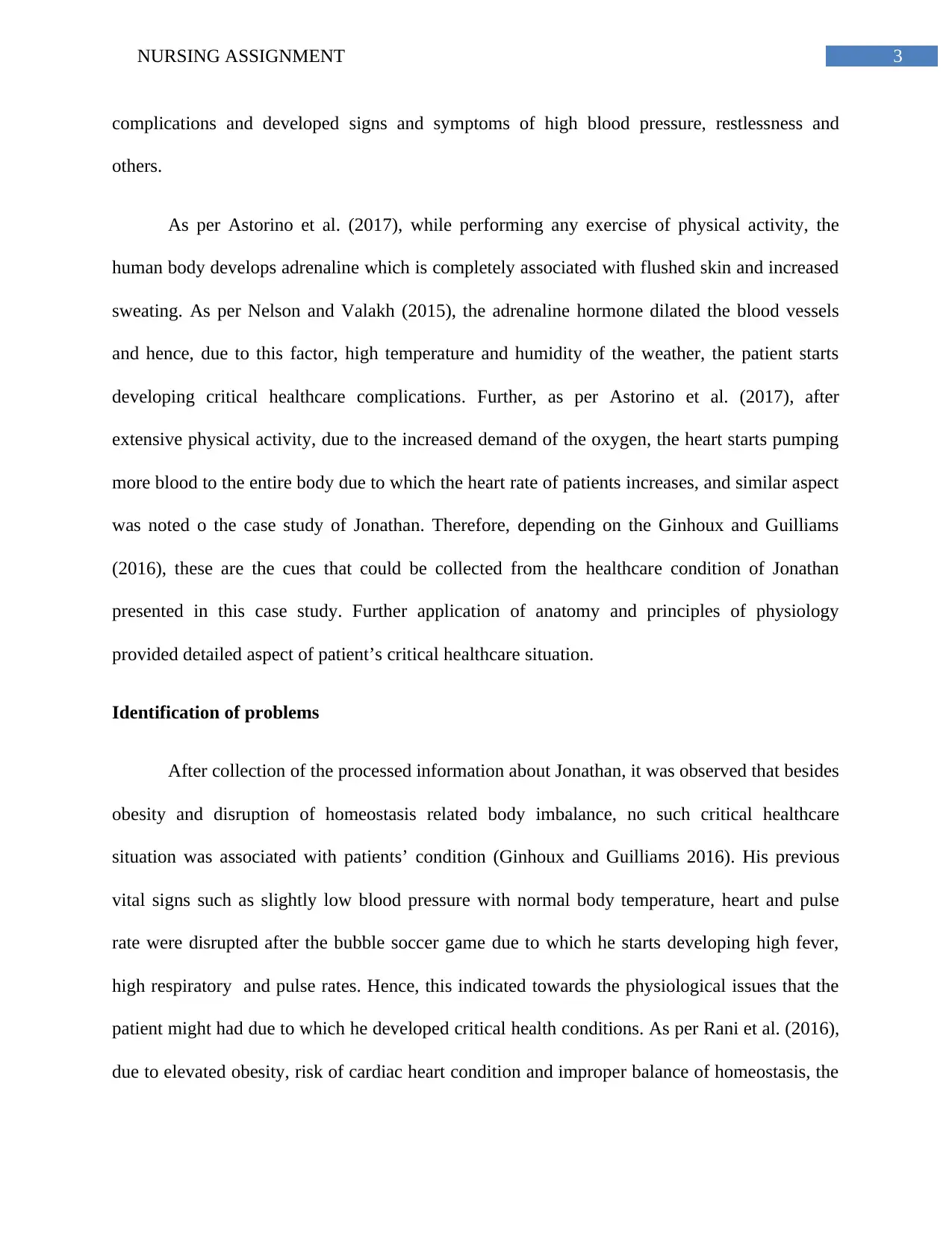
3NURSING ASSIGNMENT
complications and developed signs and symptoms of high blood pressure, restlessness and
others.
As per Astorino et al. (2017), while performing any exercise of physical activity, the
human body develops adrenaline which is completely associated with flushed skin and increased
sweating. As per Nelson and Valakh (2015), the adrenaline hormone dilated the blood vessels
and hence, due to this factor, high temperature and humidity of the weather, the patient starts
developing critical healthcare complications. Further, as per Astorino et al. (2017), after
extensive physical activity, due to the increased demand of the oxygen, the heart starts pumping
more blood to the entire body due to which the heart rate of patients increases, and similar aspect
was noted o the case study of Jonathan. Therefore, depending on the Ginhoux and Guilliams
(2016), these are the cues that could be collected from the healthcare condition of Jonathan
presented in this case study. Further application of anatomy and principles of physiology
provided detailed aspect of patient’s critical healthcare situation.
Identification of problems
After collection of the processed information about Jonathan, it was observed that besides
obesity and disruption of homeostasis related body imbalance, no such critical healthcare
situation was associated with patients’ condition (Ginhoux and Guilliams 2016). His previous
vital signs such as slightly low blood pressure with normal body temperature, heart and pulse
rate were disrupted after the bubble soccer game due to which he starts developing high fever,
high respiratory and pulse rates. Hence, this indicated towards the physiological issues that the
patient might had due to which he developed critical health conditions. As per Rani et al. (2016),
due to elevated obesity, risk of cardiac heart condition and improper balance of homeostasis, the
complications and developed signs and symptoms of high blood pressure, restlessness and
others.
As per Astorino et al. (2017), while performing any exercise of physical activity, the
human body develops adrenaline which is completely associated with flushed skin and increased
sweating. As per Nelson and Valakh (2015), the adrenaline hormone dilated the blood vessels
and hence, due to this factor, high temperature and humidity of the weather, the patient starts
developing critical healthcare complications. Further, as per Astorino et al. (2017), after
extensive physical activity, due to the increased demand of the oxygen, the heart starts pumping
more blood to the entire body due to which the heart rate of patients increases, and similar aspect
was noted o the case study of Jonathan. Therefore, depending on the Ginhoux and Guilliams
(2016), these are the cues that could be collected from the healthcare condition of Jonathan
presented in this case study. Further application of anatomy and principles of physiology
provided detailed aspect of patient’s critical healthcare situation.
Identification of problems
After collection of the processed information about Jonathan, it was observed that besides
obesity and disruption of homeostasis related body imbalance, no such critical healthcare
situation was associated with patients’ condition (Ginhoux and Guilliams 2016). His previous
vital signs such as slightly low blood pressure with normal body temperature, heart and pulse
rate were disrupted after the bubble soccer game due to which he starts developing high fever,
high respiratory and pulse rates. Hence, this indicated towards the physiological issues that the
patient might had due to which he developed critical health conditions. As per Rani et al. (2016),
due to elevated obesity, risk of cardiac heart condition and improper balance of homeostasis, the
Paraphrase This Document
Need a fresh take? Get an instant paraphrase of this document with our AI Paraphraser
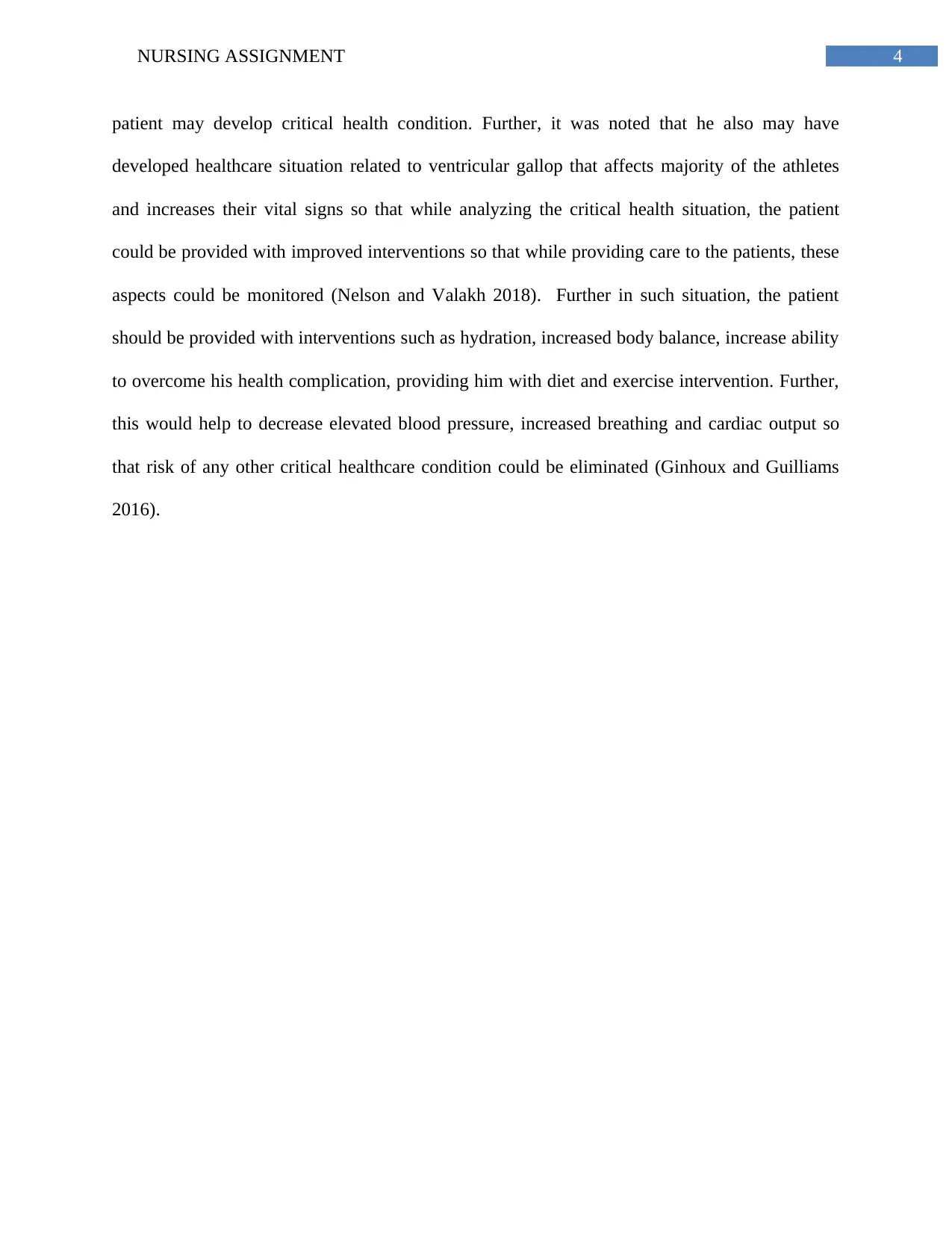
4NURSING ASSIGNMENT
patient may develop critical health condition. Further, it was noted that he also may have
developed healthcare situation related to ventricular gallop that affects majority of the athletes
and increases their vital signs so that while analyzing the critical health situation, the patient
could be provided with improved interventions so that while providing care to the patients, these
aspects could be monitored (Nelson and Valakh 2018). Further in such situation, the patient
should be provided with interventions such as hydration, increased body balance, increase ability
to overcome his health complication, providing him with diet and exercise intervention. Further,
this would help to decrease elevated blood pressure, increased breathing and cardiac output so
that risk of any other critical healthcare condition could be eliminated (Ginhoux and Guilliams
2016).
patient may develop critical health condition. Further, it was noted that he also may have
developed healthcare situation related to ventricular gallop that affects majority of the athletes
and increases their vital signs so that while analyzing the critical health situation, the patient
could be provided with improved interventions so that while providing care to the patients, these
aspects could be monitored (Nelson and Valakh 2018). Further in such situation, the patient
should be provided with interventions such as hydration, increased body balance, increase ability
to overcome his health complication, providing him with diet and exercise intervention. Further,
this would help to decrease elevated blood pressure, increased breathing and cardiac output so
that risk of any other critical healthcare condition could be eliminated (Ginhoux and Guilliams
2016).
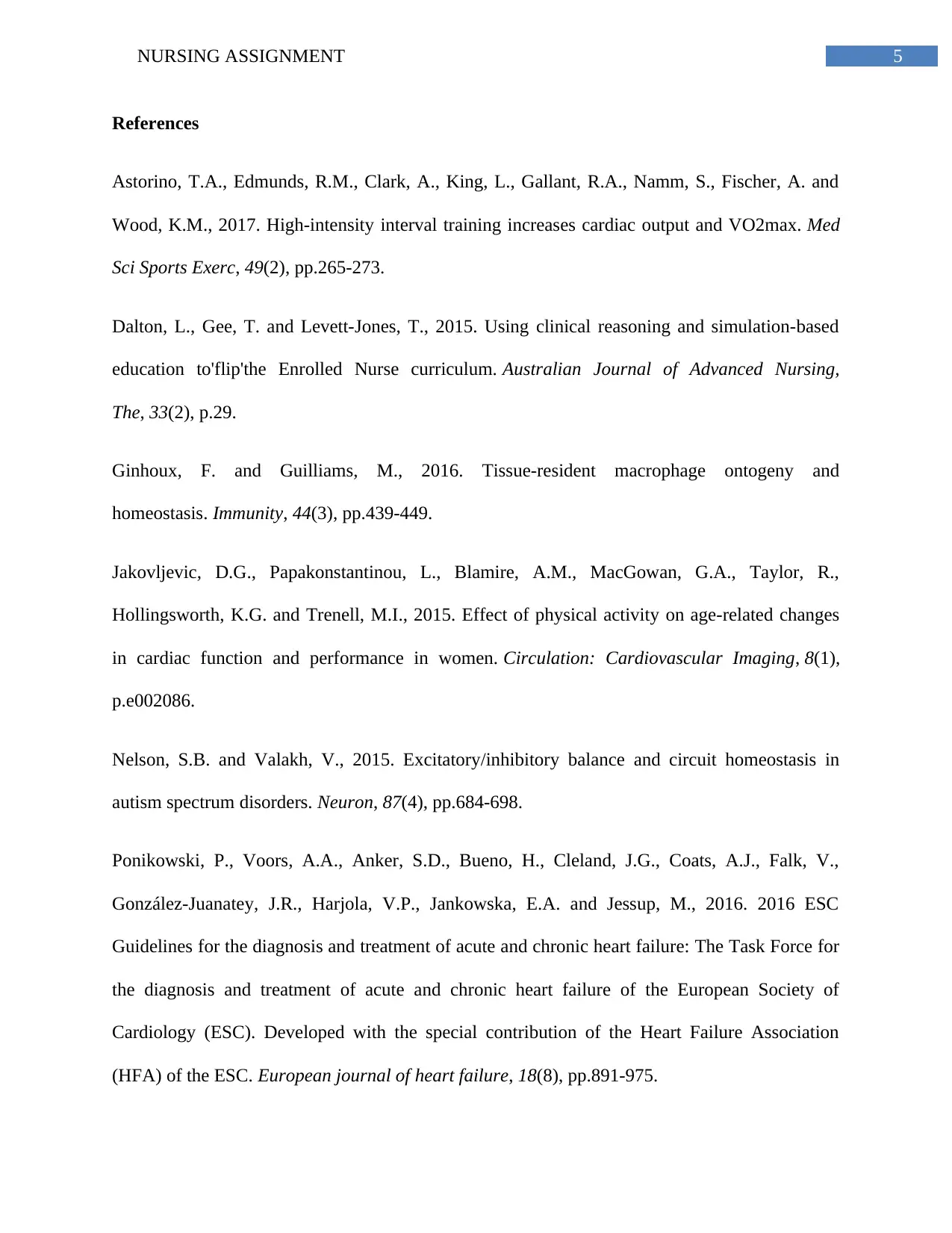
5NURSING ASSIGNMENT
References
Astorino, T.A., Edmunds, R.M., Clark, A., King, L., Gallant, R.A., Namm, S., Fischer, A. and
Wood, K.M., 2017. High-intensity interval training increases cardiac output and VO2max. Med
Sci Sports Exerc, 49(2), pp.265-273.
Dalton, L., Gee, T. and Levett-Jones, T., 2015. Using clinical reasoning and simulation-based
education to'flip'the Enrolled Nurse curriculum. Australian Journal of Advanced Nursing,
The, 33(2), p.29.
Ginhoux, F. and Guilliams, M., 2016. Tissue-resident macrophage ontogeny and
homeostasis. Immunity, 44(3), pp.439-449.
Jakovljevic, D.G., Papakonstantinou, L., Blamire, A.M., MacGowan, G.A., Taylor, R.,
Hollingsworth, K.G. and Trenell, M.I., 2015. Effect of physical activity on age-related changes
in cardiac function and performance in women. Circulation: Cardiovascular Imaging, 8(1),
p.e002086.
Nelson, S.B. and Valakh, V., 2015. Excitatory/inhibitory balance and circuit homeostasis in
autism spectrum disorders. Neuron, 87(4), pp.684-698.
Ponikowski, P., Voors, A.A., Anker, S.D., Bueno, H., Cleland, J.G., Coats, A.J., Falk, V.,
González‐Juanatey, J.R., Harjola, V.P., Jankowska, E.A. and Jessup, M., 2016. 2016 ESC
Guidelines for the diagnosis and treatment of acute and chronic heart failure: The Task Force for
the diagnosis and treatment of acute and chronic heart failure of the European Society of
Cardiology (ESC). Developed with the special contribution of the Heart Failure Association
(HFA) of the ESC. European journal of heart failure, 18(8), pp.891-975.
References
Astorino, T.A., Edmunds, R.M., Clark, A., King, L., Gallant, R.A., Namm, S., Fischer, A. and
Wood, K.M., 2017. High-intensity interval training increases cardiac output and VO2max. Med
Sci Sports Exerc, 49(2), pp.265-273.
Dalton, L., Gee, T. and Levett-Jones, T., 2015. Using clinical reasoning and simulation-based
education to'flip'the Enrolled Nurse curriculum. Australian Journal of Advanced Nursing,
The, 33(2), p.29.
Ginhoux, F. and Guilliams, M., 2016. Tissue-resident macrophage ontogeny and
homeostasis. Immunity, 44(3), pp.439-449.
Jakovljevic, D.G., Papakonstantinou, L., Blamire, A.M., MacGowan, G.A., Taylor, R.,
Hollingsworth, K.G. and Trenell, M.I., 2015. Effect of physical activity on age-related changes
in cardiac function and performance in women. Circulation: Cardiovascular Imaging, 8(1),
p.e002086.
Nelson, S.B. and Valakh, V., 2015. Excitatory/inhibitory balance and circuit homeostasis in
autism spectrum disorders. Neuron, 87(4), pp.684-698.
Ponikowski, P., Voors, A.A., Anker, S.D., Bueno, H., Cleland, J.G., Coats, A.J., Falk, V.,
González‐Juanatey, J.R., Harjola, V.P., Jankowska, E.A. and Jessup, M., 2016. 2016 ESC
Guidelines for the diagnosis and treatment of acute and chronic heart failure: The Task Force for
the diagnosis and treatment of acute and chronic heart failure of the European Society of
Cardiology (ESC). Developed with the special contribution of the Heart Failure Association
(HFA) of the ESC. European journal of heart failure, 18(8), pp.891-975.
⊘ This is a preview!⊘
Do you want full access?
Subscribe today to unlock all pages.

Trusted by 1+ million students worldwide
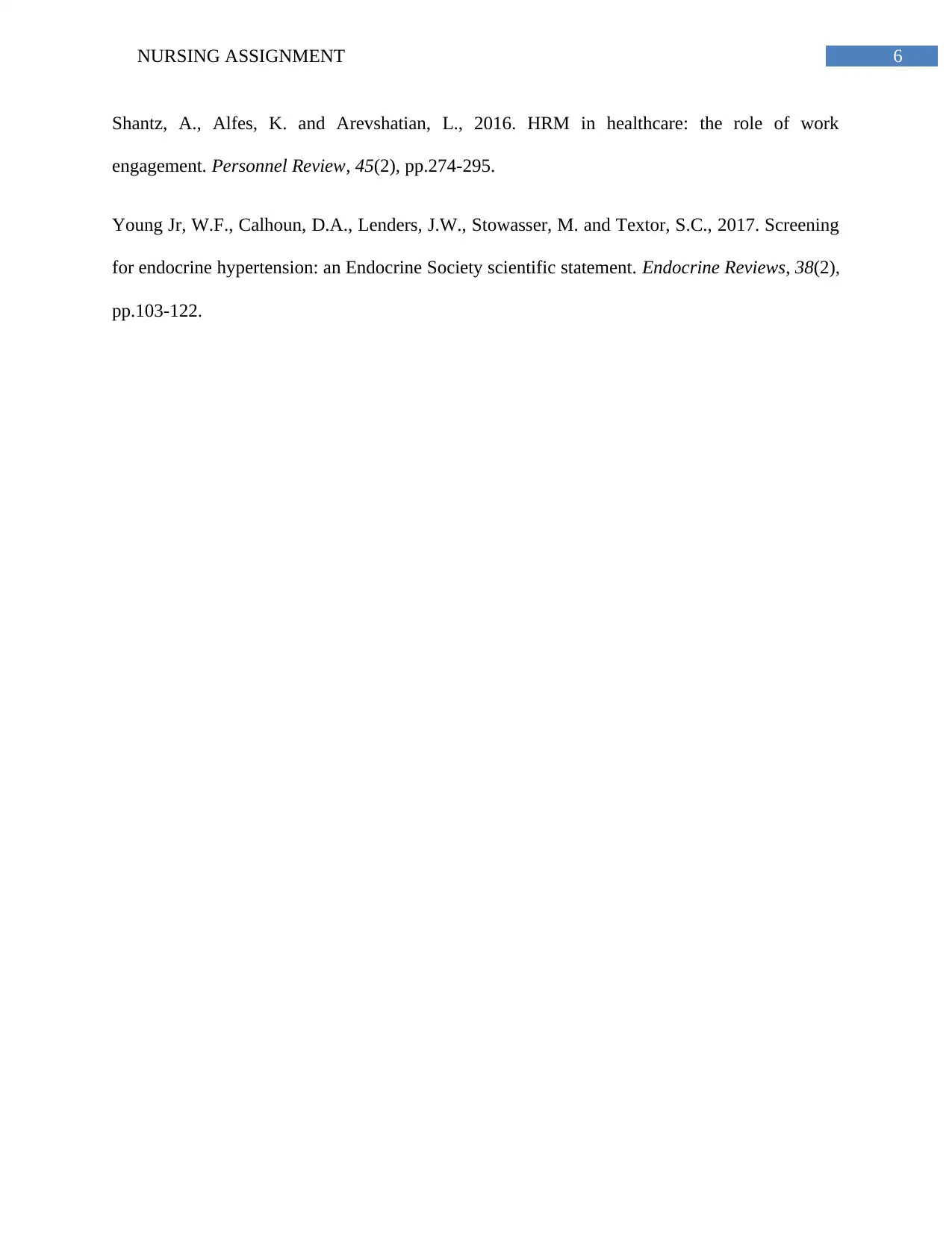
6NURSING ASSIGNMENT
Shantz, A., Alfes, K. and Arevshatian, L., 2016. HRM in healthcare: the role of work
engagement. Personnel Review, 45(2), pp.274-295.
Young Jr, W.F., Calhoun, D.A., Lenders, J.W., Stowasser, M. and Textor, S.C., 2017. Screening
for endocrine hypertension: an Endocrine Society scientific statement. Endocrine Reviews, 38(2),
pp.103-122.
Shantz, A., Alfes, K. and Arevshatian, L., 2016. HRM in healthcare: the role of work
engagement. Personnel Review, 45(2), pp.274-295.
Young Jr, W.F., Calhoun, D.A., Lenders, J.W., Stowasser, M. and Textor, S.C., 2017. Screening
for endocrine hypertension: an Endocrine Society scientific statement. Endocrine Reviews, 38(2),
pp.103-122.
1 out of 7
Related Documents
Your All-in-One AI-Powered Toolkit for Academic Success.
+13062052269
info@desklib.com
Available 24*7 on WhatsApp / Email
![[object Object]](/_next/static/media/star-bottom.7253800d.svg)
Unlock your academic potential
Copyright © 2020–2025 A2Z Services. All Rights Reserved. Developed and managed by ZUCOL.





